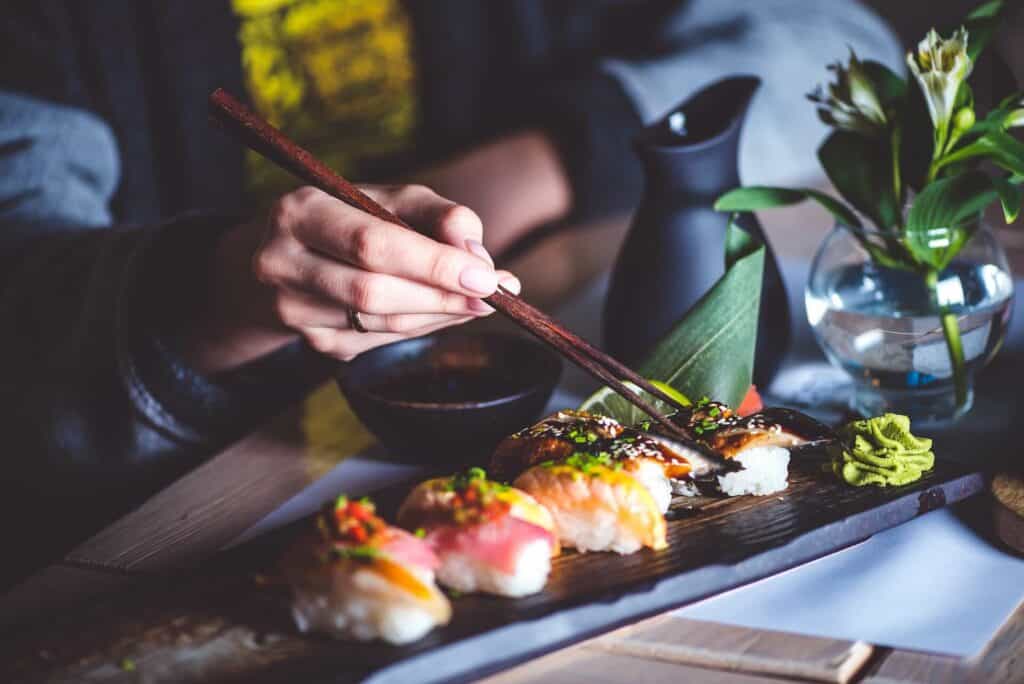Sushi is among the most popular foods in the world – in all parts of the globe. If you’re a fan of Japanese specialties but not an expert in proper ways of eating sushi, my guide will be helpful to you. Do you know when to eat sushi and how to do it according to cultural norms? Keep reading for all the best tips regarding sushi and become an expert in Japanese cuisine.
Sushi is typically eaten for lunch or dinner. It’s best to keep sushi consumption up to 2-3 rolls per week and avoid eating it on Saturdays, Sundays, and Mondays – most Japanese restaurants don’t get fresh fish on weekends and are closed on Mondays. Also, those who have a compromised immune system or are pregnant should avoid sushi.


Although you’re not obligated to know all the rules for eating sushi, it’s nice to learn more about Japanese culture and avoid mistakes that can be considered offensive. Also, when we’re talking about sushi, it’s crucial to know all about the health risks and benefits of this food – the raw fish makes this a bit more complicated than your ordinary food.
When to Eat Sushi – All the Information You Need
Sushi is suitable for both lunch and dinner. It serves as an excellent food for business lunches, first dates, parties, and basically anything you can think of. You can’t go wrong if you choose sushi for any occasion or even get it to spice up the most tedious day. The only important thing is not to eat it too much, as it has some health risks I’ll mention later in this text.
On Which Days Should You Avoid Sushi?
There’s no exact rule for this, but the fact is that some days are better than others. Most Japanese restaurants don’t get fresh fish on Sundays and usually Saturdays, so it’s wise to skip the weekends if you want the freshest meal. Also, you’ll find that most quality places are closed on Mondays, so this day is out as well. The rest of the week is perfectly fine – of course if you choose a good restaurant.
How Often Can You Eat This Delicious Japanese Food?
The recommendations for healthy adults are 2-3 sushi rolls per week, which is 10-15 sushi pieces. I recommend you follow this rule, as too much sushi can lead to some health issues. So, with this information in mind, you must be wondering who should avoid these delicious Japanese specialties entirely. There are population groups that should stay clear of sushi – I’ve listed them below.
- Those who are pregnant or breastfeeding,
- Young children,
- Elderly,
- People with diseases of the immune system,
- People on immunosuppressants.
Is Sushi a Healthy Meal?
Sushi is a traditional Japanese food made with short-grain rice (that’s prepared with vinegar), raw fish, seafood, and vegetables. This excellent mix of ingredients makes it a well-balanced meal full of carbs, proteins, healthy fatty acids, and essential nutrients.
Fish is an excellent source of protein, and some species such as salmon and mackerel are rich in omega-3 fatty acids crucial for the cardiovascular system. Fish also contains a lot of vitamins D and B12, selenium, iodine, and zinc. When you take a look at life expectancy in Japan, it’s clear that their diet has plenty of health benefits.
Possible Health Risks of Sushi
Even though the benefits outweigh the risks of this food, it’s crucial to mention them. Raw fish in sushi contains mercury, and ingesting that in higher concentrations is dangerous. So, it’s always better to choose types of fish with lower levels of mercury, such as salmon and mackerel.
Seafood also poses a risk of a disease called anisakiasis, caused by a parasitic worm that attaches to your digestive tract. This disease is very rare, but the prevalence in the US is on the rise. Another possibility is Listeria infection, which is especially dangerous in pregnant people. Here’s what you can do to prevent these issues:
- Eat sushi only in reputable, high-quality restaurants.
- Avoid takeout sushi.
- Skip on homemade sushi.
- Pick the right type of fish.
The Basic Rules for Eating Sushi
If you want the best and most authentic experience of eating sushi, there are rules you should be aware of. No one’s to say you can’t enjoy the dish without following them, but they do help get the most out of your meal. I’ve gathered the most important dos and don’ts you should learn.
| DOS | DON’TS |
| Picking the roll with fingers or chopsticks | Picking the roll with a fork or cutting it with a knife |
| Eating the roll in one bite | Mixing wasabi with soy sauce |
| Dipping the sushi in soy sauce fish-down | Dipping the rice in soy sauce |
| Cleansing the palate with pickled ginger | Eating ginger in the same bite as sushi roll |
| Holding chopsticks loosely in your dominant hand | Rubbing chopsticks together to remove splinters |
| Adding a bit of wasabi on top of the fish | Too much soy sauce |
Sushi Is a Delicious, Healthy Food, But Should Be Eaten in Moderation
After reading my brief guide on sushi, you are ready to become an authentic Japanese food lover and enjoy these delicious, unique dishes that the whole world loves. Sushi is very popular and has countless benefits in addition to the outstanding taste. Still, as I’ve mentioned, there are a few health risks to keep in mind – after all, nothing’s perfect, right? So, go ahead and explore the sushi world, find the best restaurants in your area, and enjoy the lovely sushi rolls, but do it in moderation. In this case, there can be too much of a good thing.